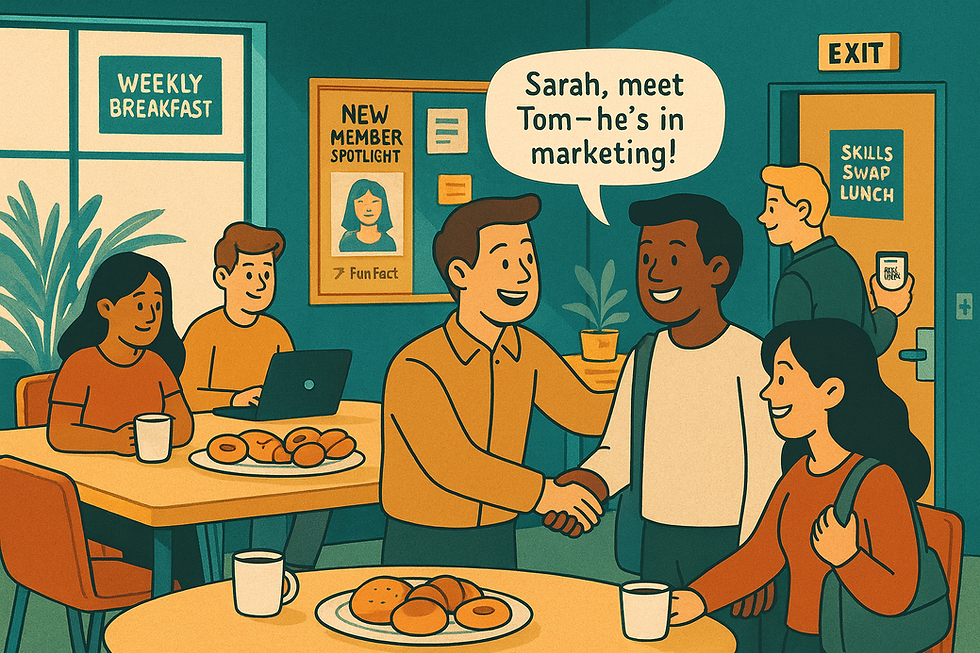Actionable Ideas for Building a Strong Coworking Community
- Phil Ingram

- Aug 19
- 3 min read

Anyone can rent out a desk, provide fast Wi-Fi, and offer decent coffee. What sets a truly successful coworking space apart, what keeps members renewing their contracts and telling their friends, is the strength of its community.
A vibrant community doesn't happen by accident. It requires deliberate effort and thoughtful design. It’s about moving from being a landlord to being a host, a connector, and a facilitator. If you're ready to build a community that becomes your most powerful asset, here are some actionable ideas you can implement today.
1. Onboard Members, Don't Just Sign Them Up
A new member’s first week is critical. A generic welcome email and a keycard aren’t enough. You need to integrate them into the social fabric of the space from day one.
The Guided Tour Plus: During the initial tour, don't just point out the printers and the toilets. Introduce the new member to at least three other people by name and mention what they do. A simple, "Sarah, this is Tom. Tom's just launched a new marketing agency. Sarah runs a brilliant graphic design studio; you two should chat." This simple act breaks down barriers immediately.
New Member Spotlight: Create a small, dedicated space—either on a physical bulletin board or in your digital community channel—to feature new members. A photo, their name, their company, and a fun fact can be a great conversation starter for existing members.
2. Engineer Serendipity with Regular Rituals
The most powerful connections are often forged in casual, unplanned moments. Your job is to create the environment where those moments can happen more frequently.
The Weekly Breakfast: It doesn't need to be extravagant. A simple spread of pastries, fruit, and coffee every Tuesday morning creates a natural gathering point. It gives members a low-pressure reason to step away from their desks and chat with their neighbours.
Friday Afternoon Wind-Down: Mark the end of the working week with a casual social. A few beers in the fridge or a bottle of wine in the kitchen from 4 p.m. onwards signals that it's okay to relax and connect. It’s a ritual that members will quickly come to look forward to.
3. Empower Member-Led Initiatives
The strongest communities are not top-down; the members themselves build them. Your role is to empower them to take the lead.
Support Their Passions: Do you have a group of members who are all keen runners? Help them start a running club. Is there a demand for a book club or a board game night? Provide the space and help with the initial promotion.
Create a 'Skills Swap' Lunch: Once a month, host a lunch where one member gives a short, 15-minute presentation on a topic they are an expert in. This could be anything from "SEO Basics for Beginners" to "How to Take Better Photos with Your Smartphone." It positions your members as experts and facilitates valuable knowledge sharing.
4. Extend the Coworking Community Beyond Your Walls
A truly valuable membership doesn't end at your front door. By building partnerships with other local businesses, you can add tangible value and position your coworking space as a central hub in the local ecosystem.
This is where a simple tool can make a big impact. Imagine partnering with the coffee shop downstairs, the gym around the corner, and the sandwich bar across the street. By having them all on a unified platform like meed, you could offer your members exclusive perks—like a 10% discount on their morning coffee or a free guest pass for the gym.
Your members could collect and manage all these benefits through a single digital wallet on their phones, reinforcing the value of their coworking membership every time they engage with the local community. It's a subtle but powerful way to demonstrate that you're invested in their success, both inside and outside the office.
Building a community is a long-term investment, but it pays the best dividends. It reduces churn, drives referrals, and ultimately creates a space that people don't just want to work in, but genuinely feel they belong to.





Comments